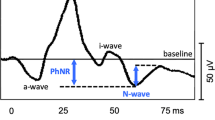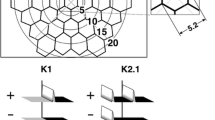Abstract
This study first compares two methods for measuring first order multifocal electroretinogram (mfERG) implicit time abnormalities in eyes with early diabetic retinopathy. Two analysis methods are used: template stretching (multiplicative scaling) of an 80 msec response epoch and template sliding (cross-correlation or additive scaling) of portions of responses containing the major waveform features. The study also compares the relative sensitivities of N1, P1 and N2 implicit time assessed by cross-correlation. The nature of the change in the mfERG waveform associated with diabetes is also assessed. MfERGs were recorded from 15 eyes of 15 individuals with diabetes and early non-proliferative retinopathy and 20 eyes of 20 healthy control subjects of similar age. Implicit time determined by template stretching is more frequently abnormal in the eyes of the diabetic subjects than the implicit time of any of the components assessed by template sliding. This is attributable to the lower variability of the template stretching implicit time measure in normals. Of the components, P1 is most often abnormal in the eyes of individuals with diabetes. Responses recorded from retinal areas with retinopathic signs are more often abnormal than those from other areas. Later components of the response are not delayed more than earlier ones. We conclude that template stretching is a sensitive measurement technique, but that it does not fully capture the effect of diabetes on the first order mfERG well.
Similar content being viewed by others
References
Sutter EE, Tran D. The eld topography of ERG com-ponents in man –I.The photopic luminance response. Vision Res 1992; 32:433–46.
Bearse MA, Sutter EE. Imaging localized retinal dys-function with the multifocal electroretinogram. J Opt Soc Am A Opt Image Sci Vis 1996; 13:634–40.
Hood DC. Assessing retinal function with the multifocal technique. Prog Ret Eye Res 2000; 19:607–46.
Palmowski AM, Sutter EE, Bearse MA Jr, et al. Map-ping of retinal function in diabetic retinopathy using the multifocal electroretinogram. Invest Ophthalmol Vis Sci 1997; 38:2586–96.
Fortune B, Schneck ME, Adams AJ. Multifocal electro-retinogram delays reveal local retinal dysfunction in early diabetic retinopathy.Invest Ophthalmol Vis Sci 1999; 40:2638–51.
Kurtenbach A, Langrova H, Zrenner E. Multifocal oscil-latory potentials in type 1 diabetes without retinopathy. Invest Ophthalmol Vis Sci 2000; 41:3234–41.
Greenstein VC, Holopigian K, Hood DC, et al.The nat-ure and extent of retinal dysfunction associated with dia-betic macular edema. Invest Ophthalmol Vis Sci 2000; 41:3643–54.
Shimada Y, Li Y, Bearse MA, Sutter EE, Fung W. Assessment of early retinal changes in diabetes using a new multifocal ERG protocol.Br J Ophthalmol 2001; 85:414–9.
Yu M, Zhang X, Zhong X, et al. Variation of multifocal electroretinograms in different stages of diabetic retinop-athy.Chin J Optom Ophthalmol 2001; 3:81–5.
Yamamoto S, Yamamoto T, Hayashi M, Takeuchi S. Morphological and functional analyses of diabetic macu-lar edema by optical coherence tomography and multifo-cal electroretinograms.Graefes Arch Clin Exp Ophthalmol 2001; 239:96–101.
Bearse MA, Han Y, Schneck ME, Adams AJ. Retinal function in control and diabetic eyes mapped with the slow.ash multifocal electroretinogram. Invest Ophthal-mol Vis Sci 2004; 45:296–304.
Han Y, Bearse MA Jr, Schneck ME, Barez S, Jacobsen C, Adams AJ. Towards optimal ltering of 'standard' multifocal electroretinogram (mfERG)recordings:nd-ings in normal and diabetic subjects. Br J Ophthalmol 2004; 88:543–50.
Han Y, Adams AJ, Bearse MA, Schneck ME. Multifocal electroretinogram (mfERG)and short wavelength auto-mated perimetry (SWAP)measures in diabetic eyes with little or no retinopathy.Arch Ophthalmol (in press).
Hood DC, Li J.A technique for measuring individual multifocal ERG records.In:YD, ed.Trends in Optics and Photonics, Optical Society of America: Washington, DC, 1997; 280–3.
ETDRSR Group, Fundus photographic risk factors for progression of diabetic retinopathy.ETDRS report number 12. Ophthalmology 1991; 98:823–33.
Hood DC, Holopigian K, Seiple W, et al. Assessment of local retinal function in patients with retinitis pigmentosa using the multifocal ERG technique.Vision Res 1998; 38:163–79.
Seeliger M, Kretschmann U, Apfelstedt-Sylla E, et al. Multifocal electroretinography in retinitis pigmentosa. Am J Ophthalmol 1998; 125:214–26.
Miyake Y, Horiguchi M, Tomita N, et al.Occult macu-lar dystrophy. Am J Ophthalmol 1996; 122:644–53.
Han Y, Bearse MA, Schneck ME, et al. Multifocal elec-troretinogram (mfERG)delays identify sites of subse-quent diabetic retinopathy. Invest Ophthalmol Vis Sci 2004; 45:948–54.
Author information
Authors and Affiliations
Rights and permissions
About this article
Cite this article
Schneck, M., Bearse, M., Han, Y. et al. Comparison of mfERG waveform components and implicit time measurement techniques for detecting functional change in early diabetic eye disease. Doc Ophthalmol 108, 223–230 (2004). https://doi.org/10.1007/s10633-004-8745-z
Issue Date:
DOI: https://doi.org/10.1007/s10633-004-8745-z




